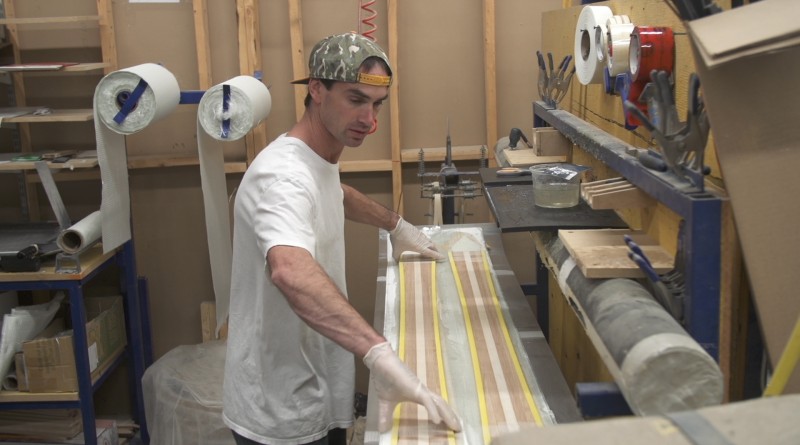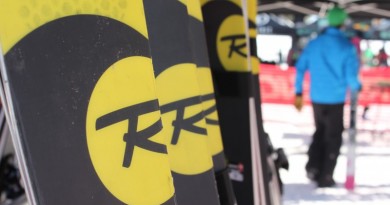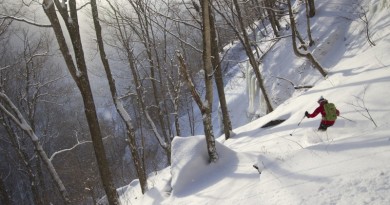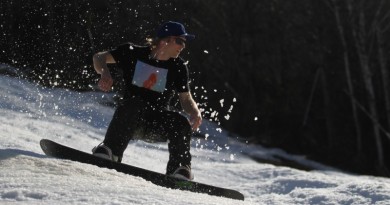Jason Levinthal shows you your next pair of skis – and it isn’t in stores
A pioneer in ski manufacturing and design, Jason Levinthal works to keep his company personal by focusing on the skiers.
BURLINGTON– Sitting on a black leather couch in a stylish modern studio office in downtown Burlington, Jason Levinthal insists he’s a skier first- then an entrepreneur. “My customers are me,” he says. “They’re the people I want to go skiing with and that’s who I want to be talking to, selling to and working with to develop the best ski possible.”
Indeed, it’s not even his office that we’re currently occupying; it belongs to a friend’s graphic design firm and Levinthal has established his own cubicle clustered with a few prototype skis and a desk he built himself. Most of his work is done with a laptop and a cell phone — and that’s just the way he likes it.
But don’t let the guy in jeans, plain white t-shirt and a snap-back baseball cap fool you. While his unofficial workspace may not be a corner office in Manhattan, it is where he continues to design new prototypes, fill orders, and check in with the factory in Quebec where his skis are made.
Levinthal pressed the first pair of twin tips in his garage as a senior capstone design project at the University of Buffalo. Since then, he developed one of the most progressive and recognizable ski brands on the slopes — Line Skis. After pressing the first-ever twin tip ski, he spent more than 18 years in the ski business (with Line and afterwards when it was bought by K2), tested more than 1,000 prototypes, designed and brought to market more than 250 models of award-winning skis and helped rejuvenate an entire sport when it seemed to decline.
And now, he’s starting again with J Skis, a new, hard-charging brand that could change how you buy your skis.
The roots of Leventhal’s latest venture began when he was a senior at the University of Buffalo, studying graphics and product design. In the 1990s, more young people were turning to snowboarding instead of skiing. Action sports in the 1990s were expanding in all kinds of exciting directions. Roller-blading, wake boarding and mountain biking all saw explosive new growth. While resorts were opening terrain parks where only snowboarders were allowed, the popular skis of the day were pointy, straight and very stiff.
“Skiing was desperate for anything new,” he says. “It was so stagnant and every single young person chose a snowboard instead of skis.”
Wanting to breathe new life into the sport he enjoyed, Levinthal designed his own ski press, which pumped water heated by a camp stove through copper pipes to heat and cure epoxy. He used lumber from a hardware store and scavenged old edges from discarded snowboards. Pressure was applied using a car jack. With his homemade press and collection of materials, he made a ski entirely from scratch.
When he took his handmade prototype to his home mountain, Holiday Valley, in Ellicottville, N.Y for some testing, he was able to ski backwards and slide rails – both well beyond the capabilities of normal skis.
“It was closer to today’s skis than anything else at the time,” he recalls. ‘It was twice as wide as a normal ski; it was twin-tipped, center-mounted, symmetric and had a deep sidecut. It had everything that today’s skis have.”
The skis were also very short, earning them the title of “ski boards.” But they were the only twin-tipped skis at the time with equal height tip and tails.
With his early prototype, he went to the Snow Sport Industry of America’s national convention in Las Vegas. Just a few weeks later, he landed his first contract with a Japanese distributor for 1,000 pairs – this, at a time when he was only making one pair per day in his parent’s garage. When the order arrived, he had only made 30 pairs.
So that summer, he recruited his friends and family and worked day and night in a rented garage in Albany to fill the order.
“It was the greatest problem ever,” he says. “I didn’t know holidays and I didn’t know anyone. When I came home from college, I was about starting a ski company.”
That first order of 1,000 pairs was the start of Line Skis, the first company to move skiing in an exciting new direction.
“We were the credible core brand in what was the only saving hope for skiing,” says the 42-year-old die-hard skier. In those early days, Levinthal would make trips to Jiminy Peak and Stratton to test prototypes and then return to the garage to try something different. In 1997, Line received the first patent for twin tips.
A second major victory for Levinthal came in 1998, when the Winter X Games had the first ski slopestyle event. Levinthal won a Bronze medal and a high school friend, Mike Nick, took Gold.
The variety of skiing gained new followers and with it, interested investors. By 1999, he and his friends were making 4,000 pairs of skis every year. In 1999, Canadian manufacturer Karhu, which at the time was producing Karhu cross country skis and a third of Burton’s snowboards, started to produce Line skis, bringing Levinthal to Burlington, where he’s been since. The skis were still under the Line brand, but their investment relieved Levinthal of the stresses of producing ski after ski. With Karhu making the skis in Cowansville, Quebec, he was free to continue designing in Burlington.
In 2006, Line was bought again, this time by K2 Sports, a much larger company based in Seattle, Wash., but Levinthal was reluctant to leave Vermont, so he was able to stay on as the president of Line and continue to design prototypes from Burlington.
“I love this place too much,” he said of his adopted hometown. “As icy as it is, as cold as it is and no matter how much powder is out West, the culture, attitude and soul of Vermont and Burlington was something I couldn’t give up.”
New company, new strategy
In large companies, it takes months of scheduling and complex logistics to develop new products. On top of that, companies have to sell thousands of pairs of skis in order to turn a profit. It takes up to two years for a pair of skis to go from just an idea through design and development to a product on the shelf. It’s a model of business that requires lots of integrated layers and if you want to sell skis on a massive scale, then that’s the business model for you.
Levinthal phrases this in a helpful metaphor: “You’re on this tanker of a boat and if the world changes, you can’t do a 180-degree turn like you could if you were on a jetski,” he said.
While he was still at Line, Levinthal observed how new Internet technology allowed start-up companies to grow quickly, yet still struggled to the capacities of much larger companies. Levinthal was impressed by startups, but noted that as long as they tried to function on the same scale as larger companies they couldn’t last.
“I was saying: this is awesome, but you can’t operate in the traditional way,” he recalls. “You think that you have to or you should because that’s the only way you’ve seen it done, but it won’t work because I know how long it takes to get it up and moving. Sometimes you have to create your own playing field.”
It was an observation that got him thinking about trying a different approach to designing, producing and selling skis.
“I had had this idea about how I would do it differently this time – without any regrets of how I did it the first time – but more so to leverage today’s technology to succeed at a smaller scale faster,” he says. “I think I’m going to be profitable and sustainable in a couple of years instead of a couple decades.”
In the fall of last year, Levinthal left his first company to try a new way of designing and selling skis, one based more on interactions with his customers than moving large volumes of products, calling the new venture “J Skis.”
To help with the design and production of his first two models Levinthal recruited a handful of trusted industry professionals, including Francois Sylvain, a ski engineer who worked on Line skis from 1999 to 2007 and Mark “Fank” Fankhauser, who has produced graphics for Line Skis and Ride Snowboards for the past 15 years and contributes artwork from Seattle.
By Christmas, he designed his first ski and by the end of the season, he’d sold 300 pairs. You won’t find J Skis in any stores and that’s exactly Levinthal’s plan.
“I’d rather own one pizza store and have a great time with just a couple of employees than have 20 stores with 20 times the headache and not make a dollar more,” he says.
Levinthal’s two models of skis include the 90mm waist Whipit and the 98mm waist Allplay, available in 169 171, 178 and 184 lengths. The skis are constructed with pre-cured, pre-stretched carbon fiber laminates that are lighter than fiberglass and have more energy, Levinthal says, adding that the maple and aspen cores of the skis are lightweight and extremely shock absorbent, while also holding the binding screws securely. For added durability and shock absorption, the skis feature full height sidewalls and the thickest edges available on the market – 2.5mm by 2.5mm.
These top-quality materials are popular among many leading brands, but by selling each pair of skis directly to the consumer, he’s able to keep the price tag low; a pair of his costs between $520 and $560 compared to a pair of new skis from other brands that can cost as much as $700 or $800. This, he says, is what makes J Skis unique.
“I’m designing skis for the people who are abusing their skis the most,” he says. “This time, when I started another company, instead of needing to sell 30,000 to be profitable, I need to sell 3,000 because I’m selling it direct. I’m not paying a sales rep, who’s managed by a sales manager, to sell to a retailer or go to a trade show. Now, you pay me with a credit card before I ship, you get full retail price and I can afford to operate a business sustainably with very small volume.”
Graphics feature camouflage, Hawaiian shirts, cats in space and collaborations with artists. The designs are limited edition – only 90 or 100 pairs are produced of each graphic and Levinthal puts his initials on every pair of skis he ships and his discerning customers supply their input on new graphics or designs via Twitter, Facebook or Instagram. By using the latest in Internet technology and keeping his operations as small as he can, Levinthal is able to keep costs down and directly interface with the people who are using his skis.
That kind of transparency has paid off in some very big ways. Since getting started, the J Skis Facebook page has over 30,000 “Likes” and 9,000 people signed up to receive email updates and free stickers from him. His website was selling 20 pairs of skis per week in September. Last month, using the crowdfunding website Kickstarter, Levinthal raised $20,000 in just eight days to design, produce, press and eventually ship new models of a powder ski. In testing, J’s first-ever pair of powder-spec skis won an Official Selection award from Skiing Magazine and as of this writing, his Kickstarter campaign has taken in over $40,000 to develop the ski.
While at Line, under K2’s ownership, his interactions with the people using the skis he designed was limited to the reps he met at trade shows.
Now, he says, that’s changed. After getting the brand up and running last October, this winter will be his first full season with established models of skis and Levinthal is ready for the snow to start falling so he can head out onto the slopes at Bolton Valley or Stowe to test new skis or share a lift ride with the people who ski them.
“Right now, every human on the planet can reach me,” he says. “My phone number and email are right there on the website. It’s incredibly personal and I’m no longer insulated from the customer using the skis I made.”




